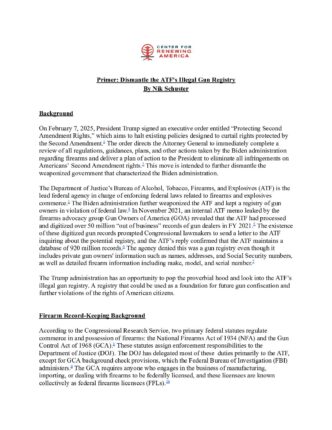
Primer: Dismantle the ATF’s Illegal Gun Registry
Background
On February 7, 2025, President Trump signed an executive order entitled “Protecting Second Amendment Rights,” which aims to halt existing policies designed to curtail rights protected by the Second Amendment.1 The order directs the Attorney General to immediately complete a review of all regulations, guidances, plans, and other actions taken by the Biden administration regarding firearms and deliver a plan of action to the President to eliminate all infringements on Americans’ Second Amendment rights.2 This move is intended to further dismantle the weaponized government that characterized the Biden administration.
The Department of Justice’s Bureau of Alcohol, Tobacco, Firearms, and Explosives (ATF) is the lead federal agency in charge of enforcing federal laws related to firearms and explosives commerce.3 The Biden administration further weaponized the ATF and kept a registry of gun owners in violation of federal law.4 In November 2021, an internal ATF memo leaked by the firearms advocacy group Gun Owners of America (GOA) revealed that the ATF had processed and digitized over 50 million “out of business” records of gun dealers in FY 2021.5 The existence of these digitized gun records prompted Congressional lawmakers to send a letter to the ATF inquiring about the potential registry, and the ATF’s reply confirmed that the ATF maintains a database of 920 million records.6 The agency denied this was a gun registry even though it includes private gun owners’ information such as names, addresses, and Social Security numbers, as well as detailed firearm information including make, model, and serial number.7
The Trump administration has an opportunity to pop the proverbial hood and look into the ATF’s illegal gun registry. A registry that could be used as a foundation for future gun confiscation and further violations of the rights of American citizens.
Firearm Record-Keeping Background
According to the Congressional Research Service, two primary federal statutes regulate commerce in and possession of firearms: the National Firearms Act of 1934 (NFA) and the Gun Control Act of 1968 (GCA).8 These statutes assign enforcement responsibilities to the Department of Justice (DOJ). The DOJ has delegated most of these duties primarily to the ATF, except for GCA background check provisions, which the Federal Bureau of Investigation (FBI) administers.9 The GCA requires anyone who engages in the business of manufacturing, importing, or dealing with firearms to be federally licensed, and these licensees are known collectively as federal firearms licensees (FFLs).10
Under the GCA, Congress authorized a decentralized system of recordkeeping, allowing ATF to trace a firearm’s chain of commerce from manufacturer or importer to dealer and the first retail purchaser of record.11 FFLs must maintain firearms transaction records for a minimum of 20 years under previously issued ATF regulations, and they must submit a minimum of 20 years of their most recent transaction records to the ATF whenever they go out of business.12
Federal Gun Registry Statutory Prohibitions
Four provisions of law prohibit a national registry of most modern firearms.13 Two of these prohibitions set limits principally on the ATF, while the other two set limits on the FBI.14
Permanent ATF Appropriations Limitation
- According to the Congressional Research Service, from FY1979 through FY2012, Congress attached a provision to annual ATF appropriations that blocked a Carter administration proposed rule, and any similarly proposed rule, that would have required FFLs to submit reports on firearms sales.15 For FY2012, the word “hereafter” was attached to this provision, indicating a permanent application.16 This provision reads:
- “Provided that no funds appropriated herein or hereafter shall be available for salaries or administrative expenses in connection with consolidating or centralizing, within the Department of Justice, the records, or any portion thereof, of acquisition and disposition of firearms maintained by federal firearms licensees.”17
- “Provided that no funds appropriated herein or hereafter shall be available for salaries or administrative expenses in connection with consolidating or centralizing, within the Department of Justice, the records, or any portion thereof, of acquisition and disposition of firearms maintained by federal firearms licensees.”17
Firearms Owners’ Protection Act (FOPA), 1986
- Section 6 of the Firearms Protection Act prohibited a registry of firearms.18 The language reads:
- “No such rule or regulation prescribed after the date of the enactment of the Firearms Owners’ Protection Act may require that records required to be maintained under this chapter or any portion of the contents of such records, be recorded at or transferred to a facility owned, managed, or controlled by the United States or any State or any political subdivision thereof, nor that any system of registration of firearms, firearms owners, or firearms transactions or dispositions be established. Nothing in this section expands or restricts the Secretary’s [Attorney General’s] authority to inquire into the disposition of any firearm in the course of a criminal investigation.”19
Brady Handgun Violence Prevention Act, 1993
- The Brady Act prohibits the establishment of a firearm registry, with any records generated by the FBI’s National Instant Criminal Background Check System (NICS), except for records on those found ineligible to receive or possess firearms.20 It reads:
- “No department, agency, officer, or employee of the United States may—(1) require that any record or portion thereof generated by the system established under this section be recorded at or transferred to a facility owned, managed, or controlled by the United States or any State or political subdivision thereof; or (2) use the system established under this section to establish any system for the registration of firearms, firearm owners, or firearm transactions or dispositions, except with respect to persons, prohibited by section 922 (g) or (n) of title 18, United States Code or State law, from receiving a firearm.”21
- “No department, agency, officer, or employee of the United States may—(1) require that any record or portion thereof generated by the system established under this section be recorded at or transferred to a facility owned, managed, or controlled by the United States or any State or political subdivision thereof; or (2) use the system established under this section to establish any system for the registration of firearms, firearm owners, or firearm transactions or dispositions, except with respect to persons, prohibited by section 922 (g) or (n) of title 18, United States Code or State law, from receiving a firearm.”21
NICS Record Destruction
- From FY2004 through FY2012, Congress included a section in the annual DOJ appropriations bill that required the FBI to destroy within 24 hours background check records on persons who are found eligible to receive and possess firearms.22 In FY2012, Congress inserted “hereafter” in this provision as well.23 It reads:
- “Sec. 511. Hereafter, none of the funds appropriated pursuant to this Act or any other provision of law may be used for—(1) the implementation of any tax or fee in connection with the implementation of subsection 922(t) of title 18, United States Code; and (2) any system to implement subsection 922(t) of title 18, United States Code, that does not require and result in the destruction of any identifying information submitted by or on behalf of any person who has been determined not to be prohibited from possessing or receiving a firearm no more than 24 hours after the system advises a Federal firearms licensee that possession or receipt of a firearm by the prospective transferee would not violate subsection (g) or (n) of section 922 of title 18, United States Code, or State law.”24
ATF’s Illegal Gun Registry
As mentioned previously, an internal ATF document exposed by GOA indicated that the agency had collected over 50 million firearms transaction records in 2021 from FFLs who had gone out of business.25 Responding to a congressional inquiry, the ATF later reported having nearly 921 million out-of-business records, 94 percent of which were computerized, as of November 2021.26 The ATF maintains that this does not constitute a gun registry and that the law is being adhered to by the agency.27 However, while federal law authorizes a decentralized system of recordkeeping, it is clear that these records have been centralized.28
All FFL dealers, should they go out of business, are required to turn over Acquisition and Disposition (A&D) Records. These records include several ATF forms that contain identifying information. These include: ATF Form 4473 (includes information about the buyer and the weapons purchased), ATF Form 3310.4, AFT Form 3310.11, and ATF Form 6 & 6A. FFL dealers are required to turn over these records to the ATF within 30 days of going out of business.29
When the ATF receives records (paper or digitized) from various FFLs across the country and inputs them into ATF file systems, then hundreds of millions of records have been consolidated into one computerized system, creating a de facto registry which violates existing prohibitions in law.30 Furthermore, in 2022, the Biden administration finalized a rule requiring FFLs to retain records permanently, which overturned decades of policy that allowed these records to be destroyed after 20 years.31 This policy, when combined with the ATF’s “zero-tolerance” enforcement strategy—a weaponized power wielded to punish even minor paperwork errors severely—forced many FFLs out of business, which helped expand the database.32
Conclusion
ATF’s illegal gun registry could be used in the future to create a gun confiscation list or could be weaponized in other ways against law-abiding citizens. Over the past few years, firearms manufacturers have been de-banked or denied services simply because they make guns.33 As the Trump administration begins the process of unwinding the policies that undermine the Second Amendment, it could consider, in the absence of a compelling reason not to, the elimination of the ATF’s illegal gun registry. Congress could look at reforms like those found in the No REGISTRY Rights Act (H.R. 1271/S. 119), which requires the ATF to delete all existing firearm transaction records and allows FFLs to destroy transaction records when they go out of business, preventing any accumulation by the ATF.34
Most Americans recognize the need to both have robust protections of the right to self-defense through an expansive and originalist reading of the Second Amendment and the need to keep weapons out of the hands of violent criminals. Whatever benefits proponents of safer communities might argue that a gun registry provides us pales in comparison to the longer-term threat of a government that keeps and stores records on which Americans have firearms and what types and quantities of firearms they have. The primary purpose of the Second Amendment is to arm the citizenry of the United States to act as a check on a domestic or foreign tyranny. If the people are to remain a check on the potential tyrannical abuse of power by the United States government itself, allowing the government to persist in maintaining digitized and searchable records on the firearms its law-abiding people possess is an unmistakable trampling over the purpose of this constitutional provision.
Conclusion
1. Executive Order (February 7, 2025). “Protecting Second Amendment Rights,” The White House. https://www.whitehouse.gov/presidential-actions/2025/02/protecting-second-amendment-rights/
2. Fact Sheet (February 7, 2025). “President Donald J. Trump is Protecting Americans’ Second Amendment Rights,” The White House. https://www.whitehouse.gov/fact-sheets/2025/02/fact-sheet-president-donald-j-trump-is-protecting-americans-second-amendment-rights/
3. CRS Report (June 6, 2011). “The Bureau of Alcohol, Tobacco, Firearms and Explosives (ATF): Budget and Operations for FY2011,” The Congressional Research Service. https://crsreports.congress.gov/product/pdf/R/R41206
4. Kredo (November 6, 2021). “Biden Admin Amassing Millions of Records on US Gun Owners Amid New Crackdown on Firearms,” The Washington Free Beacon. https://freebeacon.com/biden-administration/biden-admin-amassing-millions-of-records-on-u-s-gun-owners-amid-new-crackdown-on-firearms/
5. Johnston (May 2022). “ATF’s Illegal Gun Owner Registry,” Gun Owners of America. https://forms.gunowners.org/form/atf-s-illegal-gun-registry
6. Ibid.
7. Ibid.
8. In Focus (February 5, 2024). “Statutory Federal Gun Registry Prohibitions and ATF Record Retention Requirements,” The Congressional Research Service. https://crsreports.congress.gov/product/pdf/IF/IF12057
9. Ibid.
10. Ibid.
11. Ibid.
12. Ibid.
13. Ibid.
14. Ibid.
15. Ibid.
16. Ibid.
17. Consolidated and Further Continuing Appropriations Act, 2012, P.L. 112-55, November 18, 2011, 125 Stat. 552, 609.
18. Ibid.
19. P.L. 99-308, May 19, 1986, 100 Stat. 449, 459.
20. In Focus (February 5, 2024). “Statutory Federal Gun Registry Prohibitions and ATF Record Retention Requirements,” The Congressional Research Service. https://crsreports.congress.gov/product/pdf/IF/IF12057
21. P.L. 103-159, November 30, 1993, 107 Stat. 1536, 1542.
22. In Focus (February 5, 2024). “Statutory Federal Gun Registry Prohibitions and ATF Record Retention Requirements,” The Congressional Research Service. https://crsreports.congress.gov/product/pdf/IF/IF12057
23. Ibid.
24. Consolidated and Further Continuing Appropriations Act, 2012, P.L. 112-55, November 18, 2011, 125 Stat. 552, 632.
25. Johnston (May 2022). “ATF’s Illegal Gun Owner Registry,” Gun Owners of America. https://forms.gunowners.org/form/atf-s-illegal-gun-registry
26. In Focus (February 5, 2024). “Statutory Federal Gun Registry Prohibitions and ATF Record Retention Requirements,” The Congressional Research Service. https://crsreports.congress.gov/product/pdf/IF/IF12057
27. Johnston (May 2022). “ATF’s Illegal Gun Owner Registry,” Gun Owners of America. https://forms.gunowners.org/form/atf-s-illegal-gun-registry
28. Ibid
29. National Firearms Act Handbook Ch. 14 available at https://www.atf.gov/firearms/docs/undefined/atf-national-firearms-act-handbook-chapter-14/download
30. Ibid.
31. Press Release (January 16, 2025). “Rep. Cloud and Sen. Risch Introduce Bill to Block Federal Gun Registry,” cloud.house.gov. https://cloud.house.gov/posts/release-rep-cloud-and-sen-risch-introduce-bill-to-block-federal-gun-registry
32. Ibid.
33. Fact Sheet (February 7, 2025). “President Donald J. Trump is Protecting Americans’ Second Amendment Rights,” The White House. https://www.whitehouse.gov/fact-sheets/2025/02/fact-sheet-president-donald-j-trump-is-protecting-americans-second-amendment-rights/
34. Press Release (January 16, 2025). “Rep. Cloud and Sen. Risch Introduce Bill to Block Federal Gun Registry,” cloud.house.gov. https://cloud.house.gov/posts/release-rep-cloud-and-sen-risch-introduce-bill-to-block-federal-gun-registry





